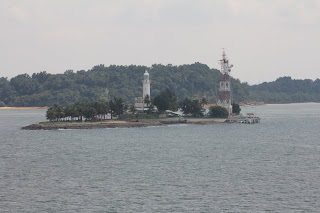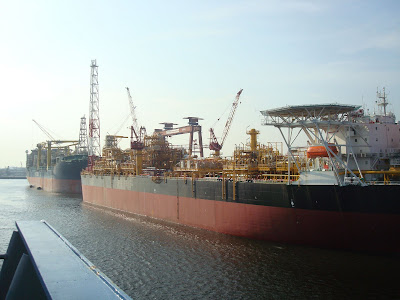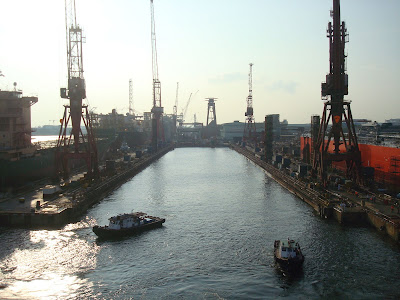




Of a Life at Sea and on Shore





It is a unique sensation to come half way around the world and feel as if you had just left the other day. My own familiarity with the Strait of Singapore, the shipping lanes in between Indonesia, Singapore and Malaysia, stems from four months spent on a cable repair vessel servicing breaks in fiber optic cables here. For weeks on end I stared at the same unmoving islands north of Horsburgh light when on a repair or the three towers of the Marina Bay Sands hotel in downtown Singapore when at anchor. These structures have now been completed since my time here in 2009 each erected independently and then bridged at the top by a soaring blimp like roof hosting trees, a pool, a nightclub and a photo shoot in the latest Sports Illustrated Swim Suit Edition.
The ship I work on is in the unenviable position of sitting empty and idle in the anchorage waiting for a spot in one of Singapore’s two shipyards. I say unenviable because from a financial perspective when any ship besides a cable repair vessel is in one spot for too long it means she isn’t making money for her owners. For the crew on the other hand it’s been a reprieve from the tedium of sea passages. With a daily launch to haul shore going crew anyone besides the 8 to 12 that needed a night off the ship has gotten their fill.
Like Orchard Towers at night the shipping lanes around Singapore are teeming with activity above, below and at street level. Just as taxis line up to escort hookers and their clientele to the closest hotel an endless train of ships arrive to pick up pilots at all hours. Anchored a thirty minute launch ride from the shore landing we're directly under the outbound flight path of Changi International. Every two minutes throughout the day and then again at night a jet takes off lifting above the tree lined shore ascending directly overhead. We’re also right in front of the high speed ferry terminal servicing Indonesia so a constant stream of high speed craft zip back and forth.
The day we arrived the Singaporean military was holding maneuvers near Raffles light house. A squadron of F-16s made circles around the anchorage while helicopters dropped off and retrieved frog men from the water. Naval patrols in the Strait are a daily occurrence and unlike the navies of another nation with which I’m familiar maintain a conspicuous radio silence.
The shipping traffic is just as I remembered; hundreds of ships pass daily, some swinging into Singapore’s myriad of terminals and others trucking right on past. Before we anchored in Singapore’s territorial waters we spent a week anchored off Indonesia in a no man’s land where every single ship save for us was a tanker waiting for a cargo. As far as the eyes could see Suez max tankers in ballast sat quietly, their crews spending what could be months trapped onboard. Every now and then an illegal sheen of oil would drift by but with so much current and so many ships finding the culprit would be impossible without aircraft. Something the Indonesians don’t seem too concerned about.
Just as when I was here before ships continued to sink right in the middle of the traffic lane a few miles away. When I explained the may-day relay on the Sat-C to one of the crew I attributed it to the law of probabilities. If there are a thousand ships in the Strait today there’s bound to be a serious collision or one junker hours from springing a leak and going down.
I’ve had the chance to get off the ship twice since arriving and neither time did Singapore disappoint. Before the sunset on my first jaunt ashore I had to return to the one and only Thai massage parlor I have ever been to. While massages in Asia are synonymous with happy endings this joint, shown to me by a sailor well versed in the ways of massage, includes nothing of the sort. Instead you are given a ridiculous looking set of loose fitting green pajamas to change into after locking your valuables away in the shower room. You ascend a staircase passing by a series of photographs featuring masseuses with awkward smiles contorting the bodies of supine victims in what appear to be painful poses. I could hardly contain my excitement.
At the top of the staircase women turn left and men turn right to meet your masseuse and enter a room filled wall to wall with thin mattresses. In the late afternoon after a stressful day in Singapore’s financial sector it isn’t unlikely that the place will be jammed packed with Asian men being pushed and pulled and kneaded like dough. My masseuse was small and when she began I was sure that her muscles weren’t fit for the job of relieving two months of accumulated stress.
The tempo, as I was to be reminded, picks up over the massage’s hour long duration and by the end, right around when she was using her elbows to push into the knot of muscle that is my hips did I remember how skilled the Thai are at this. When it was over I felt as if I had suffered a caning for spray painting graffiti on cars but soon realized that I was absolutely free of tension. Elated I joined the engineers I had gone ashore with and ordered the weirdest looking seafood we could find in celebration.
